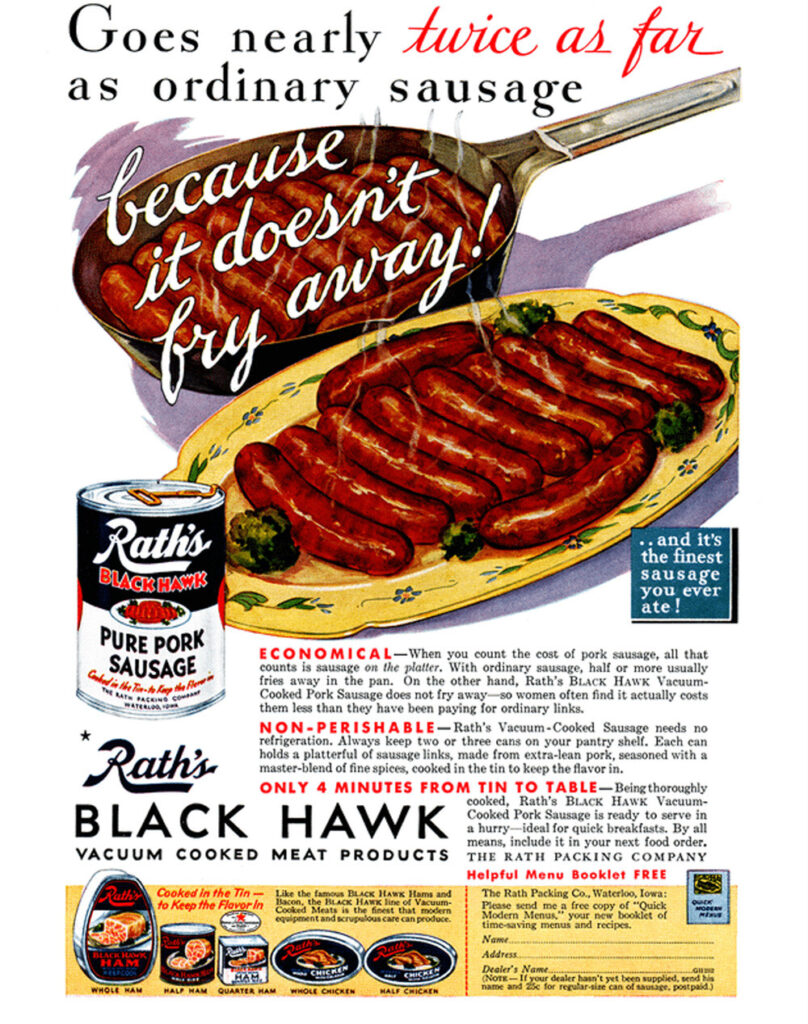You might not guess it, from hearing how much everyone complains about costs, but the average person spends a smaller chunk of their income on groceries now than anytime in the past. A lot of us spend more on food overall than people used to, because we order so much from restaurants, with a frequency that our grandparents would consider madly extravagant, but groceries? Even as inflation raises the numbers on those price tags, groceries are more affordable than ever.
With some foods, you can notice this change especially strongly. Go back a few generations, and meat was a luxury. We’re not just talking about the prime cuts that you’d consider a luxury today. In some places, all meat was a luxury, to the point that each meal had to cunningly disguise how little meat it offered. And when meat makers tried to get people to buy their wares, it looked a little something like this…
Wow, Sausages That Don’t Melt Away
Rath’s
When was the last time you saw a sausage advertised by bragging about how little vanishes in the pan? We’re guessing never. If fat boils out of a sausage and water evaporates, that’s just part of the cooking process, and it still leaves you with the cooked piece of meat you wanted.
But in 1954, Rath’s considered mass integrity the primary selling point for its canned pork sausages. It’s more economical to buy sausages that have already been cooked and just need a quick fry to heat it up, they claimed. Because when you buy four ounces of canned sausages, you want four ounces of sausages on your plate, dammit.
Note also how the ad specifies that the chef in charge of frying these sausages is a woman. This, of course, shows how the 1950s were sexist against men, who today take pride in their grilling prowess.
Fake a Steak from Ground Beef

Lever Brothers
The product this ad sells isn’t meat but vegetable shortening. But it’s advertising this Spry-brand shortening to people who want to make steak — who want to make steak out of ground beef.
“Why not just buy steak?” asks the modern reader, who can buy a pound of steak at Walmart for the same price as a bag of cookies. “Or, if you have ground beef, just cook ground beef. Ground beef is fine.” But this 1950s dish, known as a pseudo-steak, appealed to people who longed for real steak and couldn’t obtain it.
People had even more trouble getting their hands on steak during World War II, and in 1943, Betty Crocker offered cooks a recipe for something called “emergency steak.” It used ground beef, like the Spry ad above suggests, and to add bulk, since even ground beef was precious, it suggested pouring in Wheaties cereal. To simulate a bone, giving the whole amalgamation the appearance of a T-bone steak, you could insert two pieces of carrot.
Oh Boy, Hot Dogs You Can Actually Bite Through
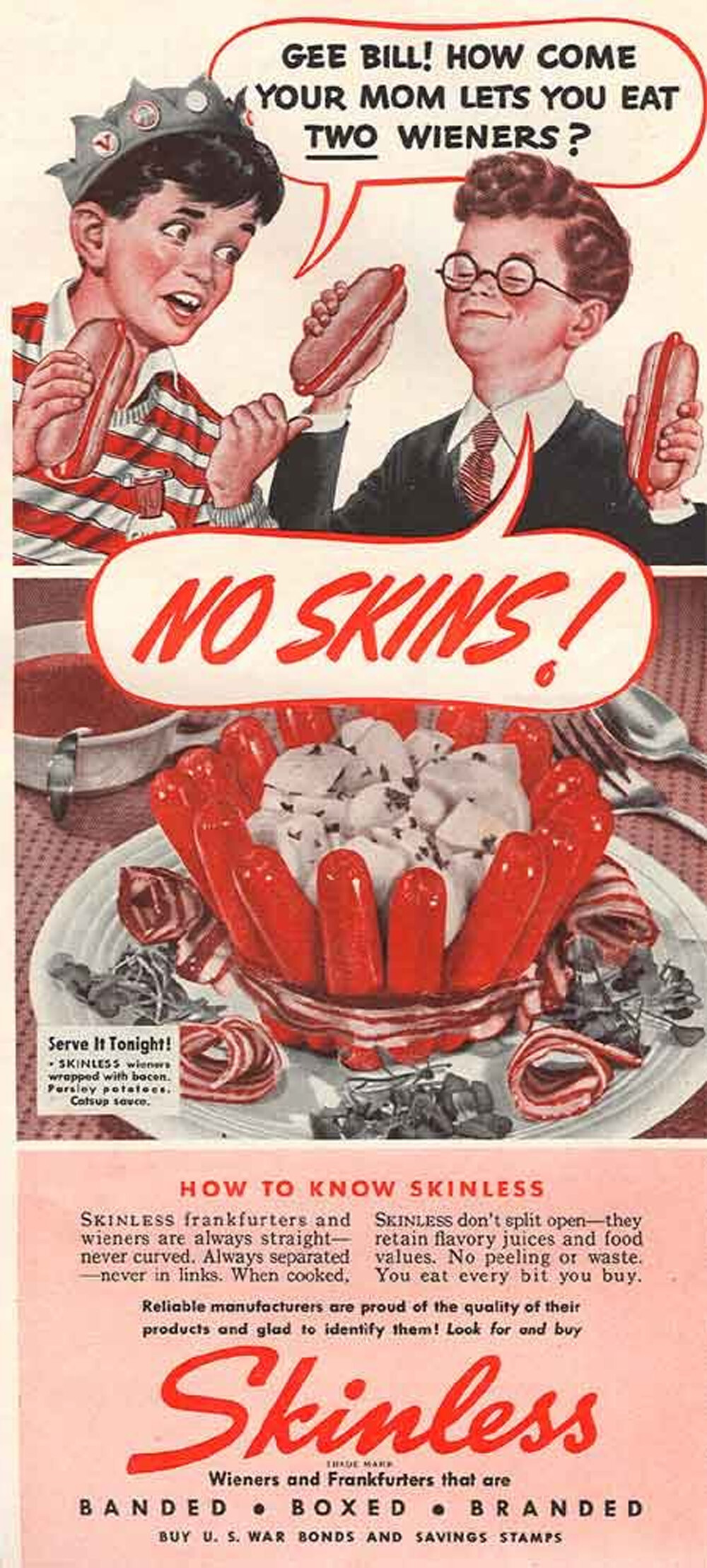
This ad from 1947 raises many questions. The first question is, “Skinless wieners?” and the answer to that is several minutes of giggling. The next questions surround that kid’s crown, which you might know only from Jughead in Archie comics. It used to be a common fashion choice and was called a whoopee cap. After that comes the big question, about what possible connection there is between wieners having no skins and that kid’s mom (giggle) letting him eat two of them (giggle).
Today, skins are no big deal on hot dogs. They are made of cellulose or natural intestines, and either way, you just bite right through them. Go back to the 1940s, and the natural casings that were the only option were much thicker than the ones we have now. You had to peel them off to get at the meat inside them.
The reason mom lets Bill there eat two wieners is she thinks these are more economical than competing sausages, because she’s paying just for the meat instead of all that discarded skin. Plus, with food safety still in its infancy, you never knew how clean intestines were. So, buy Skinlessᵀᴹ wieners. Always straight — never curved (giggle).
Sgreat Substitute
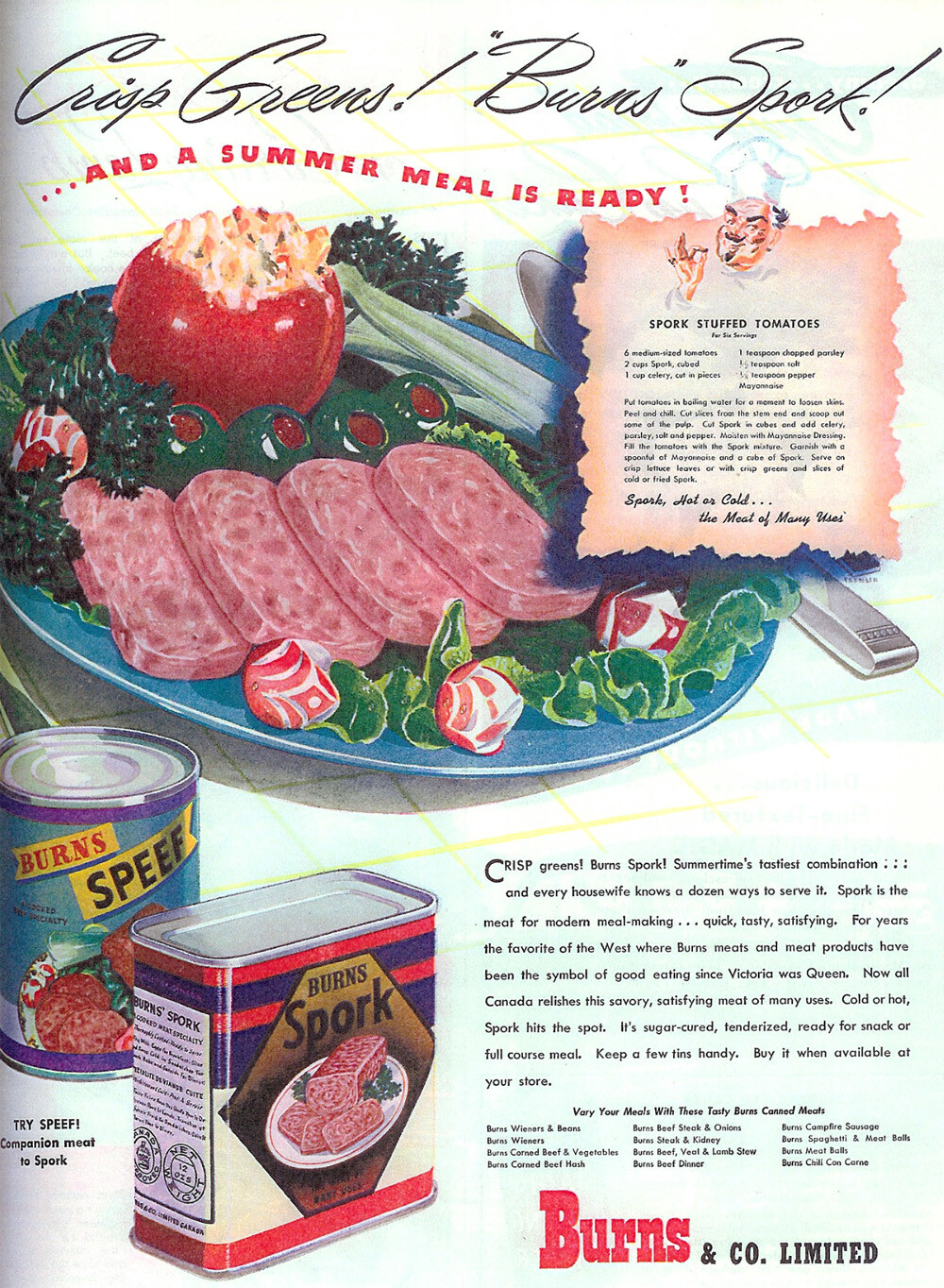
Burns
Canned luncheon meat is still a thing, and Spam rakes in billions of dollars every year. But in the past, when people found it harder to get their hands on fresh meat, canned meat was an even bigger deal, and numerous now-forgotten brands tried to get in on that Spam action.
Canadian company Burns & Co. offered their own pork product called Spork in the above 1947 ad, as well as a beef product called Speef. Precisely why everyone (including Spry vegetable shortening) loved the “sp-” prefix is a mystery. They were copying Spam, sure, but even where Spam got its own name is unknown. Many people assume it means “spiced ham,” but the guys who originally came up with the name never revealed their reasoning.
Check Out These Choice Meats

Libby’s
What comes to mind when you hear the phrase “choice meats,“ or when you think of the sort of meat that makes for “he-man meals“? If you lived in 1944, the answer would be tinned meat paste, as well as eight halves of Vienna sausages arranged on a mountain of 2-D peas.
That meat paste is deviled ham, which gets its name from how spicy it is. However, given that the only spices in there are turmeric and mustard powder, this doesn’t say very much for how hot people used to think hell is.
Mmm… Mor!
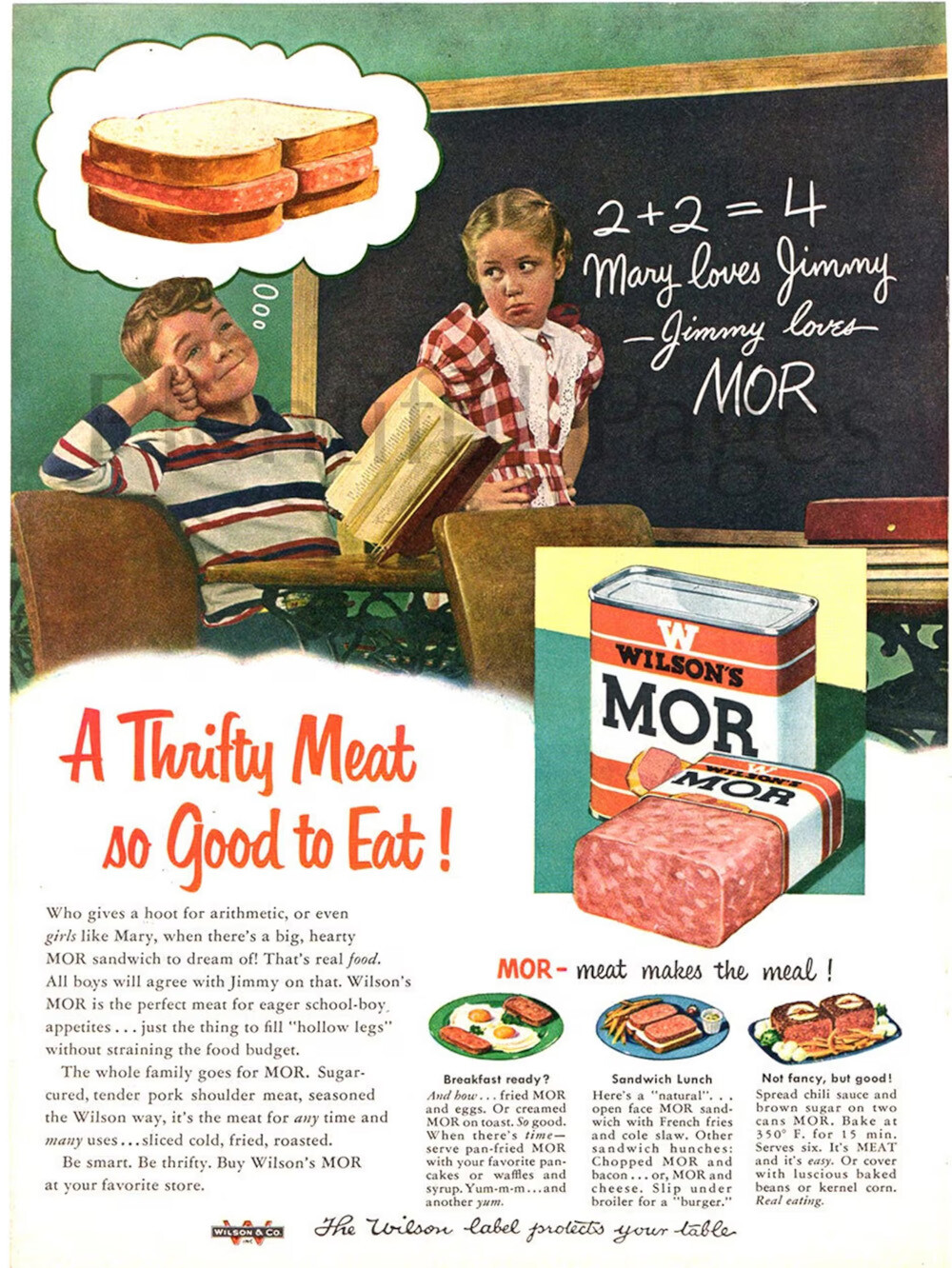
Wilson
Jimmy here loves the thought of a sandwich so much that he had no interest in either math or Mary. It makes for the sort of wholesome image that leaves many long for a simpler time.
But look at how much of this 1950s ad is devoted to explaining how this product isn’t just tasty but cheap. It’s the thrifty choice, says the ad repeatedly. Buying it won’t strain your food budget. It creates a hearty meal that saves your children from “hollow legs.”
There are kids who go to school hungry even today, but food insecurity is no longer quite so big a problem that advertisers will casually reference the fight against malnutrition. Today, we say, “Growing kids need to eat right!” We don’t say, “Feed your kid enough calories, to keep starvation at bay.”
The product here is Mor, another of those Spam competitors. This one comes from Wilson, the very company that would go on to produce Wilson volleyballs. They also offered a canned beef product known as “Bif.” And while these really did contain pork and beef, we can’t help but see those names and think of some dystopian story where no one has real meat and can only reach for suspiciously named meat substitutes.
Meat. Just Meat
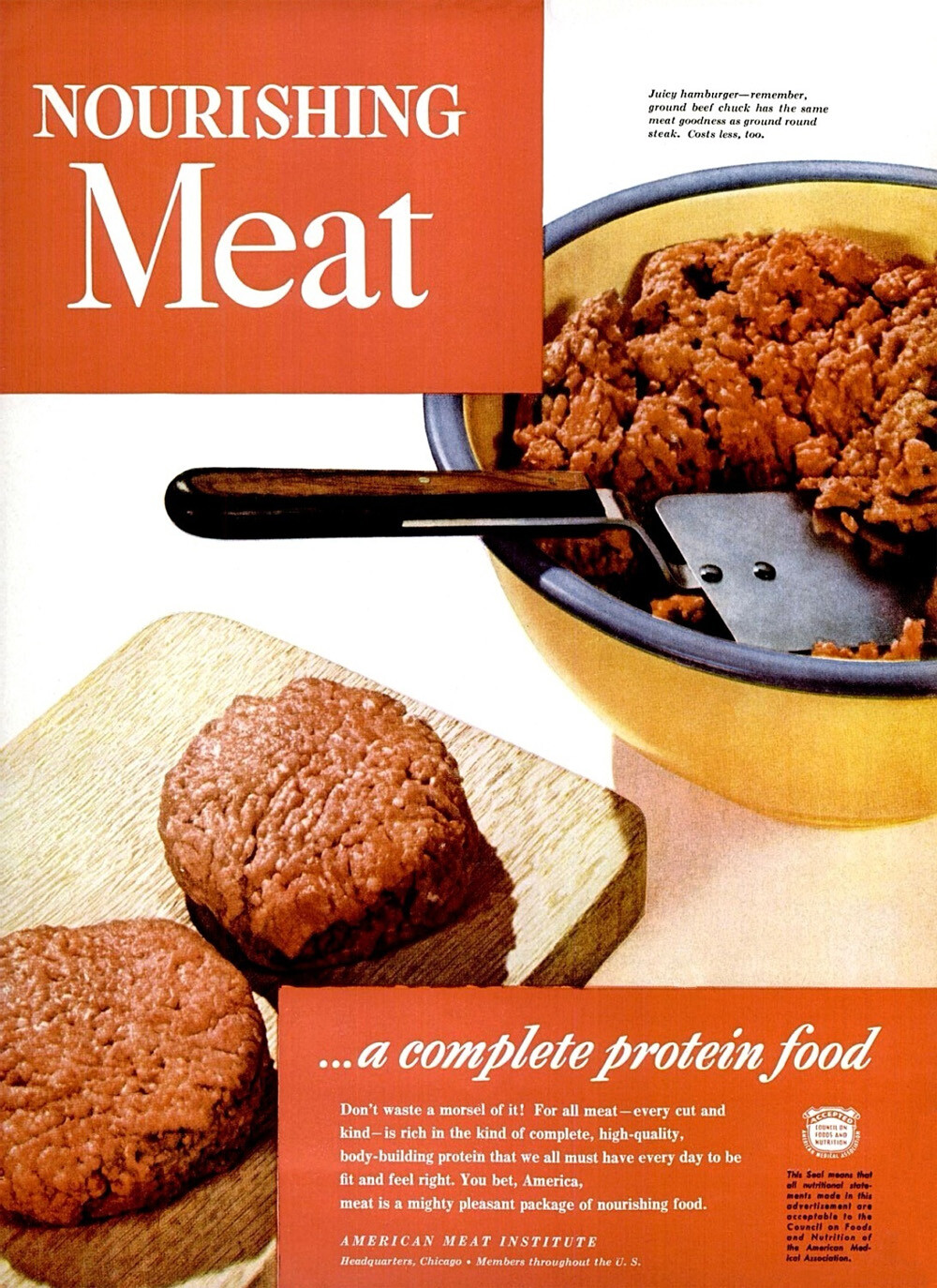
American Meat Institute
Actually, this final ad looks more dystopian than that. The idea of advertising the basic concept of meat suggests this is a world where no one has previously heard of meat, or at least a world where people need to be reminded it exists.
The American Meat Institute is still around, but they no longer run ad campaigns the way they did back in 1948. If they were to run a campaign now, we imagine they wouldn’t focus so much on a meat that “costs less” and on how you shouldn’t “waste a morsel” of it. They probably wouldn’t go with uninteresting cooked ground chuck for the picture but would pick some tempting cut of raw meat, all thick and red.

American Meat Institute
Yeah, we guess we were describing something like this second ad from the same year. But when we were imagining the meat, we weren’t picturing a hand saw grinding away at it.
Anyone else suddenly feel like chopping up a salad?
Follow Ryan Menezes on Twitter for more stuff no one should see.
Content shared from www.cracked.com.

